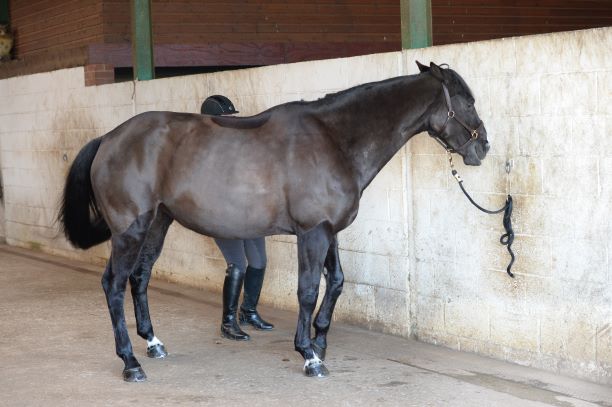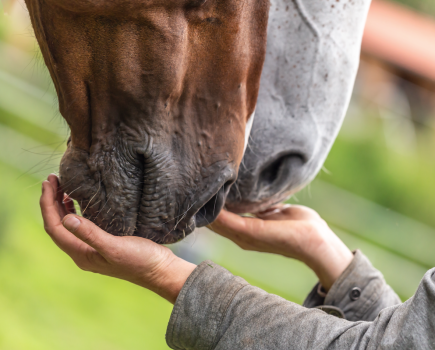I often see horses being punished for behaviour such as barging, biting, rearing, bolting or being anxious. But the only way a horse can communicate with us is through their behaviour and body language and, chances are, they’ll have been showing subtle signs of stress long before it got to the bad behaviour stage.
This is why it is vital to read the cues our horses display so that we can keep them mentally and physically healthy, and ourselves safe.
Unfortunately, we often misinterpret, don’t see or even ignore the early signs of anxiety or stress in horses and this can escalate their behaviour to something more dangerous.
Fight or flight
We can all learn much about how our horse is feeling simply by reading and understanding their behaviour. However, the signs horses give us are often subtle and hard to recognise, especially if you’re not sure what to look for.
Horses are naturally ‘fight or flight’ animals and we must always have this in the forefront of our mind. In the wild, horses are highly tuned to signs of danger or stress for the herd and they’ll do one of four things in response to it.
The four Fs
The following ‘Four Fs’ can happen in isolation or combination:
Flight
Fleeing from danger is naturally a horse’s preferred option. In ridden horses, this behaviour may manifest itself as bolting or trying to escape a situation.
Freeze
Planting or refusing to go forwards if nervous or frightened. We often see this sort of behaviour when loading a horse into a trailer or lorry.
Fight
If a horse is cornered or has learned that this strategy works and they can’t run (perhaps they’re cornered in a stable), they may fight back using behaviour such as rearing, kicking out or biting.
Fidget
If a horse can’t escape (for example if they are tied up or in a stable) they may fidget, which is also known as a displacement horse behaviour.
Displacement horse behaviour
Displacement behaviour is something you will see your horse doing all the time. It’s when they exhibit them in an inappropriate context that you should take note.
Displacement behaviour can be a sign of stress. For example, when horses are in conflict. This is when they’re anxious about a situation, confused by what’s being asked, frustrated or in pain.
Think about when you’re facing a stressful situation but can’t escape — a job interview for instance. While you wait to be called, your anxious body will go into stress (referred to as ‘fight or flight’) to prepare to escape.
You want to leave but have to stay and it’s difficult to sit still. You may walk up and down, tap your feet, drum your fingers or fiddle with a pen. Moving in this way goes some way towards relieving the stress.
Our horses perform displacement behaviours too. It might look like:
- Playing with the lead rope when tied up
- Pawing at the ground
- Chewing the fence, lead rope, or anything in reach
- Excessive yawning.
Research into animal welfare often uses the number of displacement behaviours an animal performs as a measure of stress. They are useful indicators that show how your horse feels about their environment, handling, training or being ridden.
Behaviour between horse breeds
Cold-blooded horses like cobs are often thought to be more relaxed than hot-blooded breeds like Arabs or Thoroughbreds. However, research has shown that they have similar levels of the stress hormone cortisol as hot-blooded horses in stressful situations — they just behave differently.
So, Shetlands, Shires horses, cobs, etc, appear to be less reactive and more stoic when stressed. They may freeze rather than flee or fidget.
Sadly, as a result, they’re often thought to be stubborn or naughty when in fact they may simply be too frightened to move.
Subtle horse behaviour to look for
We owe it to our horses to be vigilant about their behaviour so we can help them. Below are the subtle signs to watch for. They may only show one or two and they don’t come in any order. Stress manifests differently in every horse.
In the stable
Your horse may kick the stable door if they’re frustrated, stressed or frightened. They might call to others, turn their quarters as you enter the stable or churn up their bedding.
Being unusually withdrawn, depressed and not eating are also signs of stress. If not spotted, this could lead to aggressive horse behaviour, such as wall kicking, rushing at the door, barging, weaving, crib biting, wind sucking or box walking.
On the ground
Some behaviour you experience when handling a horse on the ground, if not the norm for your horse, could be a sign that they are nervous of being handled, have had a bad experience or have been frightened by a handler in the past.
These include being easily startled, nervous, bargy behaviour, not wanting to pick their feet up, reluctance to go forwards or refusing to be caught.
While being ridden
Missing stress signs before and when riding can lead to dangerous behaviour such as napping, bucking, spinning, rearing and bolting. Signs a horse isn’t happy being ridden are:
- Hiding in the corner of the stable when tack arrives
- Being difficult to put a bridle on
- Nipping when the girth is tightened
- Not standing still at the mounting block
- Freezing or back up
- Tilting their head to one side
- Showing reluctance to go into an arena or leave the yard for a hack.
Know your horse’s behaviour
One of the trickiest tasks as an owner is to know if your horse behaving differently from the norm. We all know horses that do things by habit rather than because they’re unhappy. It’s important to study your horse often and in all situations.
You need to build a picture of what’s normal so the subtle signs of stress in their behaviour became obvious.
A good way to do this is by keeping a diary. Notice how your horse reacts when they’re in the field with other horses, taken to a new environment (like a show) or when other people are around them.
Watch their facial expressions and body language, notice their overall posture and how this changes in difficult situations. Refer back to your notes if you see something you haven’t spotted before.
Think about the longevity of the horse’s behaviour too. If they yawn when you approach with tack but are relaxed when you ride, it’s probably nothing to worry about. If the yawning is prolonged and occurs every time you ride, then something may be worrying them or causing pain.
Once you’ve recognised any unusual behaviour ask your vet to take a look and, if it’s nothing physical, contact an equine behaviourist for help.
Recognising the face of pain
Any change in horse behaviour may be an indication that they are experiencing pain. Horses are good at hiding physical issues because, from an evolutionary perspective, showing weakness could mean ending up as a predator’s lunch. So the signs of pain can be very subtle for this reason.
Vet Sue Dyson has researched facial expressions and pain in riding horses and found that horses show signs of pain in their eyes, ears and around the mouth/nose.
The eyes will be staring or even closed, the ears back when you wouldn’t expect it, the mouth open and the chin tight with a wrinkle in the nose and the nose becoming more angular.
Horses being very above the bit was also spotted as a sign of pain. Sue urges riders and trainers to familiarise themselves with the facial signs of pain that horses show. Find out more about the research here.
A different study by vet Dr Karina Bech Gleerup looked at the body language of horses in discomfort. She found a specific ‘equine pain face’ that can be recognised in the appearance of the horse’s ears, eyes, nostrils and muzzle, as well as muscle tension across the face.
In this study, the horses had lowered ears, an angled appearance of the eyes, a withdrawn stare, nostrils flared to the side, and tension in the lips, chin and facial muscles. This information has proved useful in spotting colic in horses. Watch Dr Karina explains more about this here.
Main image © Shutterstock








